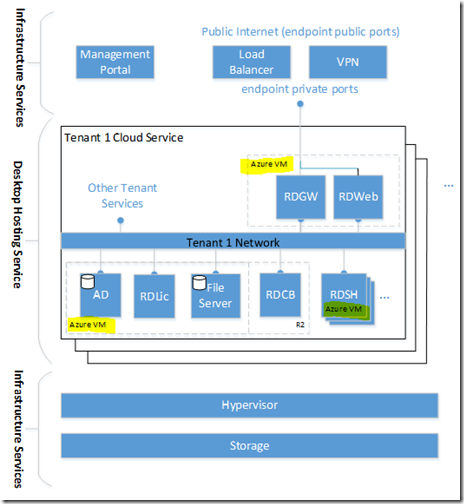Virtual Desktop Architectural Reference Guides (Including Azure) Just Released
Josh Condie – With VDI becoming more and more an opportunity for partners who host client services for small and mid-sized customers, Microsoft just released the guidance necessary to help you design effective desktop services using our latest Hyper-V, VDI and RDS technology in Windows Server 2012 and Windows 8. Key to success here is brining the costs of infrastructure down and ease of deployment and management up. Microsoft made great strides in the Server OS in both departments. For example, the support of Direct and SMB Share storage designs and inclusion of advanced storage management capabilities such as Storage Tiering, Deduplication and Thin Provisioning, bring costs down greatly for mid-sized deployments numbers. More on that at this link.
The Traditional Desktop Hosting Reference Architecture Guide can be found here.
Using Azure:
For hosting partners looking for a rapid expansion of their capacity, we now offer Windows Azure as another avenue to achieve VDI scale. Per the article:
“The primary goal is to enable hosting providers to create secure, scalable, and reliable desktop hosting solution offers for small- and medium-sized organizations with up to 1,500 users. The intended audience for this reference architecture is hosting providers who want to leverage Windows Azure infrastructure services to deliver desktop hosting services and Subscriber Access Licenses (SALs) to multiple tenants via the Microsoft Service Provider Licensing Agreement (SPLA) program.”
A logical view of the Azure architecture looks this:
The logical architecture diagram shows a two-layer architecture with the following layer definitions:
· Desktop Hosting Service: Virtual machines, networks, and storage that make up the functional service for each tenant.
· Infrastructure Services: Consists of the Azure management portal, load balancer, VPN gateway, Windows Server operating system instances running the Hyper-V role used to virtualize the physical servers, storage units, networks switches, routers, and so on that make up the Azure Infrastructure Service. The Azure infrastructure Services allow the VMs, networks, storage, and applications to be created independently from underlying hardware.
For the full technical article and guide, navigate here.
Exciting new opportunities to address the SMB market with hosted desktop are becoming a reality!
Josh

